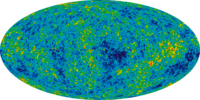
Photo from wikipedia
Recently, the hemodynamic assessments with 3D cine phase-contrast (PC) MRI (4D flow MRI) have attracted considerable attention from clinicians. Unlike 2D cine PC MRI, the technique allows for cardiac phase-resolved… Click to show full abstract
Recently, the hemodynamic assessments with 3D cine phase-contrast (PC) MRI (4D flow MRI) have attracted considerable attention from clinicians. Unlike 2D cine PC MRI, the technique allows for cardiac phase-resolved data acquisitions of flow velocity vectors within the entire FOV during a clinically viable period. Thus, the method has enabled retrospective flowmetry in the spatial and temporal axes, which are essential to derive hemodynamic parameters related to vascular homeostasis and those to the progression of the pathologies. Accelerations in imaging are critical for this technology to be clinically viable; however, a high SNR or velocity-to-noise ratio (VNR) is also vital for accurate flow measurements. In this chapter, the technologies enabling this difficult balance are discussed.
Journal Title: Magnetic Resonance in Medical Sciences
Year Published: 2022
Link to full text (if available)
Share on Social Media: Sign Up to like & get
recommendations!